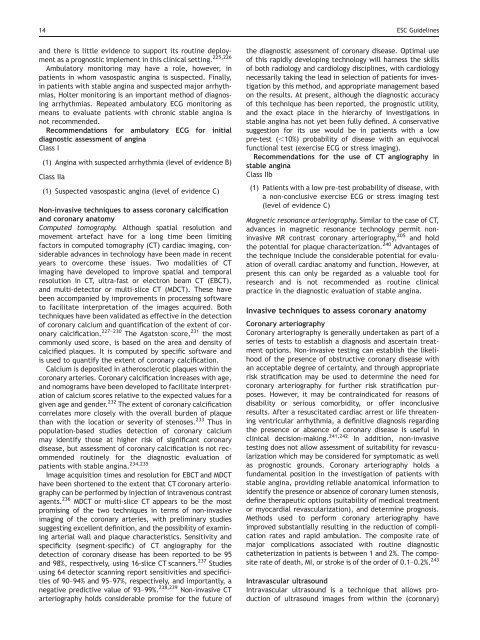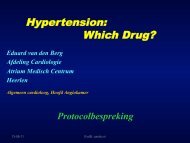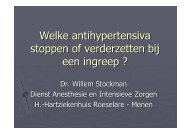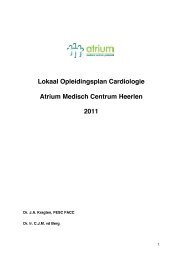Guidelines on the Management of Stable Angina Pectoris ... - Cardio
Guidelines on the Management of Stable Angina Pectoris ... - Cardio
Guidelines on the Management of Stable Angina Pectoris ... - Cardio
Create successful ePaper yourself
Turn your PDF publications into a flip-book with our unique Google optimized e-Paper software.
14 ESC <str<strong>on</strong>g>Guidelines</str<strong>on</strong>g>and <strong>the</strong>re is little evidence to support its routine deploymentas a prognostic implement in this clinical setting. 225,226Ambulatory m<strong>on</strong>itoring may have a role, however, inpatients in whom vasospastic angina is suspected. Finally,in patients with stable angina and suspected major arrhythmias,Holter m<strong>on</strong>itoring is an important method <strong>of</strong> diagnosingarrhythmias. Repeated ambulatory ECG m<strong>on</strong>itoring asmeans to evaluate patients with chr<strong>on</strong>ic stable angina isnot recommended.Recommendati<strong>on</strong>s for ambulatory ECG for initialdiagnostic assessment <strong>of</strong> anginaClass I(1) <strong>Angina</strong> with suspected arrhythmia (level <strong>of</strong> evidence B)Class IIa(1) Suspected vasospastic angina (level <strong>of</strong> evidence C)N<strong>on</strong>-invasive techniques to assess cor<strong>on</strong>ary calcificati<strong>on</strong>and cor<strong>on</strong>ary anatomyComputed tomography. Although spatial resoluti<strong>on</strong> andmovement artefact have for a l<strong>on</strong>g time been limitingfactors in computed tomography (CT) cardiac imaging, c<strong>on</strong>siderableadvances in technology have been made in recentyears to overcome <strong>the</strong>se issues. Two modalities <strong>of</strong> CTimaging have developed to improve spatial and temporalresoluti<strong>on</strong> in CT, ultra-fast or electr<strong>on</strong> beam CT (EBCT),and multi-detector or multi-slice CT (MDCT). These havebeen accompanied by improvements in processing s<strong>of</strong>twareto facilitate interpretati<strong>on</strong> <strong>of</strong> <strong>the</strong> images acquired. Bothtechniques have been validated as effective in <strong>the</strong> detecti<strong>on</strong><strong>of</strong> cor<strong>on</strong>ary calcium and quantificati<strong>on</strong> <strong>of</strong> <strong>the</strong> extent <strong>of</strong> cor<strong>on</strong>arycalcificati<strong>on</strong>. 227–230 The Agatst<strong>on</strong> score, 231 <strong>the</strong> mostcomm<strong>on</strong>ly used score, is based <strong>on</strong> <strong>the</strong> area and density <strong>of</strong>calcified plaques. It is computed by specific s<strong>of</strong>tware andis used to quantify <strong>the</strong> extent <strong>of</strong> cor<strong>on</strong>ary calcificati<strong>on</strong>.Calcium is deposited in a<strong>the</strong>rosclerotic plaques within <strong>the</strong>cor<strong>on</strong>ary arteries. Cor<strong>on</strong>ary calcificati<strong>on</strong> increases with age,and nomograms have been developed to facilitate interpretati<strong>on</strong><strong>of</strong> calcium scores relative to <strong>the</strong> expected values for agiven age and gender. 232 The extent <strong>of</strong> cor<strong>on</strong>ary calcificati<strong>on</strong>correlates more closely with <strong>the</strong> overall burden <strong>of</strong> plaquethan with <strong>the</strong> locati<strong>on</strong> or severity <strong>of</strong> stenoses. 233 Thus inpopulati<strong>on</strong>-based studies detecti<strong>on</strong> <strong>of</strong> cor<strong>on</strong>ary calciummay identify those at higher risk <strong>of</strong> significant cor<strong>on</strong>arydisease, but assessment <strong>of</strong> cor<strong>on</strong>ary calcificati<strong>on</strong> is not recommendedroutinely for <strong>the</strong> diagnostic evaluati<strong>on</strong> <strong>of</strong>patients with stable angina. 234,235Image acquisiti<strong>on</strong> times and resoluti<strong>on</strong> for EBCT and MDCThave been shortened to <strong>the</strong> extent that CT cor<strong>on</strong>ary arteriographycan be performed by injecti<strong>on</strong> <strong>of</strong> intravenous c<strong>on</strong>trastagents. 236 MDCT or multi-slice CT appears to be <strong>the</strong> mostpromising <strong>of</strong> <strong>the</strong> two techniques in terms <strong>of</strong> n<strong>on</strong>-invasiveimaging <strong>of</strong> <strong>the</strong> cor<strong>on</strong>ary arteries, with preliminary studiessuggesting excellent definiti<strong>on</strong>, and <strong>the</strong> possibility <strong>of</strong> examiningarterial wall and plaque characteristics. Sensitivity andspecificity (segment-specific) <strong>of</strong> CT angiography for <strong>the</strong>detecti<strong>on</strong> <strong>of</strong> cor<strong>on</strong>ary disease has been reported to be 95and 98%, respectively, using 16-slice CT scanners. 237 Studiesusing 64 detector scanning report sensitivities and specificities<strong>of</strong> 90–94% and 95–97%, respectively, and importantly, anegative predictive value <strong>of</strong> 93–99%. 238,239 N<strong>on</strong>-invasive CTarteriography holds c<strong>on</strong>siderable promise for <strong>the</strong> future <strong>of</strong><strong>the</strong> diagnostic assessment <strong>of</strong> cor<strong>on</strong>ary disease. Optimal use<strong>of</strong> this rapidly developing technology will harness <strong>the</strong> skills<strong>of</strong> both radiology and cardiology disciplines, with cardiologynecessarily taking <strong>the</strong> lead in selecti<strong>on</strong> <strong>of</strong> patients for investigati<strong>on</strong>by this method, and appropriate management based<strong>on</strong> <strong>the</strong> results. At present, although <strong>the</strong> diagnostic accuracy<strong>of</strong> this technique has been reported, <strong>the</strong> prognostic utility,and <strong>the</strong> exact place in <strong>the</strong> hierarchy <strong>of</strong> investigati<strong>on</strong>s instable angina has not yet been fully defined. A c<strong>on</strong>servativesuggesti<strong>on</strong> for its use would be in patients with a lowpre-test (,10%) probability <strong>of</strong> disease with an equivocalfuncti<strong>on</strong>al test (exercise ECG or stress imaging).Recommendati<strong>on</strong>s for <strong>the</strong> use <strong>of</strong> CT angiography instable anginaClass IIb(1) Patients with a low pre-test probability <strong>of</strong> disease, witha n<strong>on</strong>-c<strong>on</strong>clusive exercise ECG or stress imaging test(level <strong>of</strong> evidence C)Magnetic res<strong>on</strong>ance arteriography. Similar to <strong>the</strong> case <strong>of</strong> CT,advances in magnetic res<strong>on</strong>ance technology permit n<strong>on</strong>invasiveMR c<strong>on</strong>trast cor<strong>on</strong>ary arteriography, 205 and hold<strong>the</strong> potential for plaque characterizati<strong>on</strong>. 240 Advantages <strong>of</strong><strong>the</strong> technique include <strong>the</strong> c<strong>on</strong>siderable potential for evaluati<strong>on</strong><strong>of</strong> overall cardiac anatomy and functi<strong>on</strong>. However, atpresent this can <strong>on</strong>ly be regarded as a valuable tool forresearch and is not recommended as routine clinicalpractice in <strong>the</strong> diagnostic evaluati<strong>on</strong> <strong>of</strong> stable angina.Invasive techniques to assess cor<strong>on</strong>ary anatomyCor<strong>on</strong>ary arteriographyCor<strong>on</strong>ary arteriography is generally undertaken as part <strong>of</strong> aseries <strong>of</strong> tests to establish a diagnosis and ascertain treatmentopti<strong>on</strong>s. N<strong>on</strong>-invasive testing can establish <strong>the</strong> likelihood<strong>of</strong> <strong>the</strong> presence <strong>of</strong> obstructive cor<strong>on</strong>ary disease withan acceptable degree <strong>of</strong> certainty, and through appropriaterisk stratificati<strong>on</strong> may be used to determine <strong>the</strong> need forcor<strong>on</strong>ary arteriography for fur<strong>the</strong>r risk stratificati<strong>on</strong> purposes.However, it may be c<strong>on</strong>traindicated for reas<strong>on</strong>s <strong>of</strong>disability or serious comorbidity, or <strong>of</strong>fer inc<strong>on</strong>clusiveresults. After a resuscitated cardiac arrest or life threateningventricular arrhythmia, a definitive diagnosis regarding<strong>the</strong> presence or absence <strong>of</strong> cor<strong>on</strong>ary disease is useful inclinical decisi<strong>on</strong>-making. 241,242 In additi<strong>on</strong>, n<strong>on</strong>-invasivetesting does not allow assessment <strong>of</strong> suitability for revascularizati<strong>on</strong>which may be c<strong>on</strong>sidered for symptomatic as wellas prognostic grounds. Cor<strong>on</strong>ary arteriography holds afundamental positi<strong>on</strong> in <strong>the</strong> investigati<strong>on</strong> <strong>of</strong> patients withstable angina, providing reliable anatomical informati<strong>on</strong> toidentify <strong>the</strong> presence or absence <strong>of</strong> cor<strong>on</strong>ary lumen stenosis,define <strong>the</strong>rapeutic opti<strong>on</strong>s (suitability <strong>of</strong> medical treatmentor myocardial revascularizati<strong>on</strong>), and determine prognosis.Methods used to perform cor<strong>on</strong>ary arteriography haveimproved substantially resulting in <strong>the</strong> reducti<strong>on</strong> <strong>of</strong> complicati<strong>on</strong>rates and rapid ambulati<strong>on</strong>. The composite rate <strong>of</strong>major complicati<strong>on</strong>s associated with routine diagnosticca<strong>the</strong>terizati<strong>on</strong> in patients is between 1 and 2%. The compositerate <strong>of</strong> death, MI, or stroke is <strong>of</strong> <strong>the</strong> order <strong>of</strong> 0.1–0.2%. 243Intravascular ultrasoundIntravascular ultrasound is a technique that allows producti<strong>on</strong><strong>of</strong> ultrasound images from within <strong>the</strong> (cor<strong>on</strong>ary)














